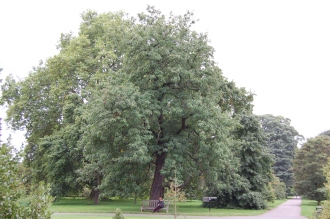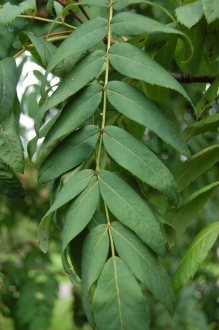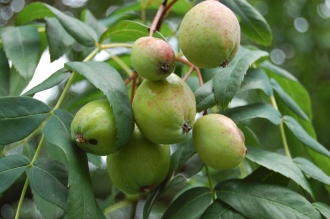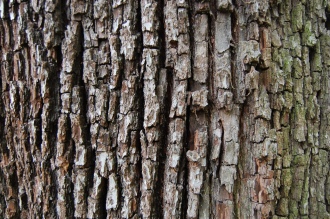Position: Full sun to light shade
Flowering period: Late spring
Soil: Moist, well drained
Eventual Height: 20m
Eventual Spread: 15m
Hardiness: 6a, 6b, 7a, 7b, 8a, 8b, 9a, 9b
Family: Rosaceae
Sorbus domestica f. Pyrifera is a long lived deciduous tree with a domed habit. Its mid green leaves are odd pinnate and up to 25cm long. Its leaflets are lanceolate with serrate margins, up to 6cm long and 1cm broad. Its leaves turn yellow before they fall in autumn. Its trunk may achieve a diameter of up to 1m. Its brown bark is smooth when young becoming fissured with age. Its white flowers are up to 15mm across appear as corymbs and are up to 14cm across. Its fruit is a green/ red pome and the Sorbus domestica f. Pyrifera form is pear shaped and up to 6cm long.
Sorbus domestica f. Pyrifera, commonly known as as the Service Tree, True Service Tree or Whitty Pear, is native to west, central and south Europe (including the UK) and south west Asia. This tree is considered to be endangered in a number of European countries, including the UK.
The etymological root of the binomial name Sorbus is from the old Latin name for this tree. Domestica is derived from the Latin domesticus meaning ’domestic’. Pyrifera is derived from the Latin pirum meaning ‘pear’ and fera meaning ‘wild’.
The landscape architect may find Sorbus domestica f. Pyrifera useful as art of a ‘native’ woodland mix. It is suitable for use as part of a native mixed hedge. Where space allows, it may also be used as part of a wildlife garden.
Ecologically, Sorbus domestica f. Pyrifera flowers are attractive to pollinating insects. Its fruit are attractive to birds and mammals.
Sorbus domestica f. Pyrifera prefers moist, fertile, well-drained soils. It tolerates most pH of soil.
Sorbus domestica f. Pyrifera requires little maintenance.








Wow that was unusual. I just wrote an really long comment but after I clicked submit my
comment didn’t appear. Grrrr… well I’m not writing all that over again.
Anyways, just wanted to say great blog!
Hello from France,
Do you live near Kew Gardens? There is a sort of a mystery about growing speed of those sorbus domestica trees. You could help by measuring the girths of those trees every 2 to 5 years at 1m30 height like forest workers do and document your measures here. This is what I am doing right now for a number of sorbus domestica trees in France, I hope that I have some 30 years left (I turn 55 on Sunday).
Arnould
I live in London, but not that close to Kew. Unfortunately I do not have the time to carry out your request. Good luck with your project. Justin
Ok then, not that important…